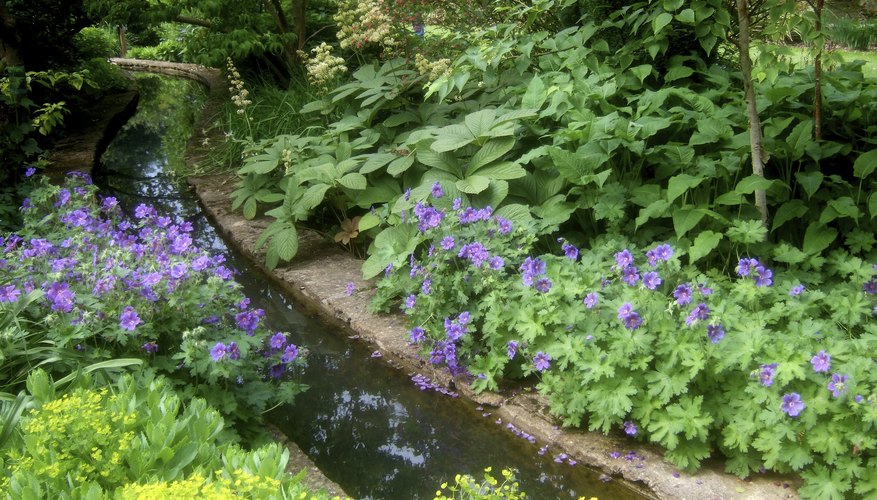Even though your garden may not provide the slope necessary for a waterfall or the space needed for a pond, you can still enjoy a water garden.
Rills, or narrow canals, wind through a back garden adding ambience and the pleasant sound of running water.
Formal rills are made of concrete or masonry and typically employ one type of flower for an elegant effect. Informal rills are similar to natural brooks. Water loving plants, such as irises, are planted along edges lined with stone.
- Even though your garden may not provide the slope necessary for a waterfall or the space needed for a pond, you can still enjoy a water garden.
- Formal rills are made of concrete or masonry and typically employ one type of flower for an elegant effect.
Choose your rill's location. Rills can stand alone or act as a transition from one area of the garden, or one area of a water feature to another.
Dig a trench at least 20 cm (8 inches) deep.
Widen and excavate one end of the trench to a depth below your region's frostline, usually 90 cm (3 feet). This area will be the sump.
Keep one end of the trench elevated at least 7.5 cm (3 inches) above the rest of the depression. This area will be your reservoir.
Remove any debris, sharp roots or stones from the trench.
Dig a small trench parallel to one side of the main trench. The smaller trench is for the flexible pipe which will circulate the water. The smaller trench need only be the depth necessary to conceal the flexible pipe below ground.
- Dig a trench at least 20 cm (8 inches) deep.
- The smaller trench need only be the depth necessary to conceal the flexible pipe below ground.
Excavate the pipe trench to allow the pipes to run from the sump area, along the length of the rill and into the reservoir. Electrical cables from the submersible pump will also run through this area. Check the manufacturer's specifications for details on how to safely run the cables.
- Excavate the pipe trench to allow the pipes to run from the sump area, along the length of the rill and into the reservoir.
Lay the pipe. Do not backfill the trench at this time.
Pack 2.5 cm (1 inch) of fine, damp sand along the walls and bottom of the trench, sump and reservoir.
Measure the butyl liner so it can be placed inside the full length of the trench, sump and reservoir. Allow for 30 cm (1 foot) of excess liner on each side of the hole.
Position the butyl liner inside the trench, sump and reservoir. Smooth any wrinkles and do not fold the liner. Secure in place with bricks or stones.
Mix the concrete using the wheelbarrow and shovel.
- Position the butyl liner inside the trench, sump and reservoir.
- Mix the concrete using the wheelbarrow and shovel.
Line the walls, bottom, sump and reservoir of the trench with 7.5 cm (3 inches) of concrete.
Ensure that the concrete is level. Wait for 48 hours for the concrete to fully set.
Mortar a line of masonry brick along the edges of the trench. The excess liner will remain on the outside of the brick. The liner will be concealed later.
Wait for the masonry brick to set before laying the decorative brick or stone.
Moisten the inside of the rill, sump and reservoir once the decorative masonry has set, usually within 48 hours.
Apply a 1.2 cm (1/2 inch) layer of fibre reinforced cement to the inside of the rill, including the reservoir and sump area.
Coat the rill with water sealant after the cement has dried.
- Mortar a line of masonry brick along the edges of the trench.
- Coat the rill with water sealant after the cement has dried.
Set the submersible pump into the sump. Connect the flexible pipe and electrical cables to the pump in accordance with the manufacturer's directions.
Add water to the rill and start the pump.
Monitor the pipes for leaks then backfill the pipe trench.
Conceal the excess liner with soil from the trench excavation.
Plant water-loving flora near the watercourse.
TIP
If the rill is connecting two watercourses, then a sump and reservoir area will not be necessary. Deep-rooted water plants such as waterlilies do not thrive near running water. Also, the depth of the rill does not allow deep water plants much room for growth. Grow plants such as Himalayan Windflower (Anemone rivularis), Cardinal Flower (Lobelia cardinalis) or hostas near the rill but do not grow plants inside of it. Conceal the sump and reservoir area of a stand alone rill by setting weatherproof boards or other deck material across the top. Place trailing containerised plants on the decking.
WARNING
Frozen water is damaging to water features. Winterise your rill, if necessary, by draining the water, disconnecting and removing the pump at season's end.
